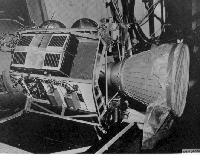Timation

Timation 1.
Timation was a series of two American military navigation satellites, which were immediate predecessors of the NAVSTAR-GPS program. Both had a mass of about 700 kg and were launched from Vandenberg Air Force Base.
Timation was based on a concept formulated in April 1964 by Roger L. Easton, of the US Naval Research Laboratory (NRL), for transmitting ranging signals along with the primary CW signal such that the distance to the target satellite could also be measured, making early orbit determination.
NRL began the TIMATION project to provide both accurate position and precise time to passive terrestrial observers. Precise spaceborne clocks would be regularly updated by a master clock on the ground. These would be linked to the user's receiving equipment by ranging signals broadcast by the satellites.
NRL scientists recognized that the TIMATION concept not only could accelerate and simplify the positioning process but could make it more accurate. However, passive ranging (in which the user on the ground is not required to emit a signal) requires an accurate and stable oscillator in the satellite. The TIMATION Project, under the direction of Roger L. Easton, concentrated on developing an improved quartz frequency standard for satellites and determining the most effective satellite constellation for providing worldwide coverage.
| spacecraft | launch date | launch vehicle | orbit |
| Timation 1 | May 31, 1967 | Thor-Agena D | 894 × 900 km × 70.0° |
| Timation 2 | Sep 30, 1969 | LT Thor-Agena D | 898 × 925 km × 70.0° |


